INTRO:
Prior to Wolfenstein 3D – which is very much the progenitor of first-person shooters with guns – there was Catacombs. It is not unlike the fictitious anti-Nazi shooter, albeit with spells instead of guns and a player character that turns increasingly skeletal instead of one that turns into raw burger as he gets hurt.
Afterwards, there was the Hexen and Heretic series, but the magic shooter genre fell off hard afterwards when it could not keep up with video game guns and bullets.
Then there was 2014, which was one of the “throwback” years when the trend in video game development is to dredge once-popular things from the past and give them a new shine. Nostalgia was a strong market factor in that year, after all. That said, Ziggurat is one of the results of resurrecting magic shooters.

PREMISE:
Ziggurat tries to dress up what little story it has with convincingly foreboding narration and cool artwork, but its tale is really a simple one: there is a lethal series of exams that aspirants have to survive in order to be accepted into a prestigious and powerful magical society.
There is mention of a magical world and such, as well as suggestions that the titular ziggurat holds some secrets. These are implied in two of the three possible endings (more on these later). Yet, any playthrough in anything other than “Gauntlet” or “Endless” is really little more than cram study of the magically lethal hands-on kind. There is a lost opportunity to expand on that world, or introduce a plot twist that justifies more emergent gameplay.
THE PLAYER CHARACTER:
Before starting a playthrough, the player picks a player character from among a roster. Only two are available from the start; the others are unlocked as the player completes feats that are described in their unlock requirements. The differences between them are mostly statistical, e.g. some of them have more health than others in return for a disadvantage in some other numerical variable. They are mainly there for people who have completionist streaks.
HEALTH:
Ziggurat is a rogue-lite game, meaning that game-overs are irreversible, at least not without cheating. The game-over condition is tied to the player character’s health counter, as expected of a game that also happens to be a shooter. That said, a game-over happens when the player character’s health goes to zero.
Maintaining health levels is not easy, as is to be expected of a rogue-lite that ties game-overs to them. There are not many readily available opportunities to restore health at the start of a run/playthrough. The player has to be either lucky enough to obtain such means (typically through some perks, which will be described later), or avoid having the player character hurt in the first place. The latter is much more in control of the player. Having the player character enter fights at near-full health is usually a mark of the player’s skill, prudence and/or dastardliness.
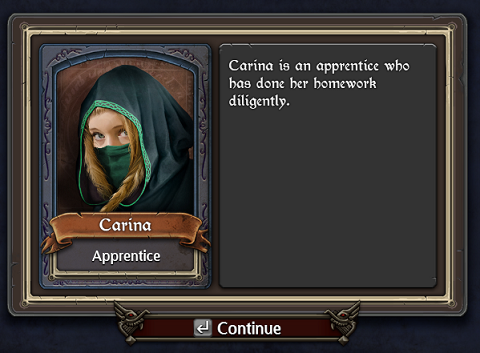
HEALING:
The main sources of healing are healing potions that defeated monsters sometimes conveniently drop; how they happen to have such things without actually using these themselves is a question that the game – and rogue-lites in general - does not consider important.
The main consideration to keep in mind is that the healing potions drop where the monsters died; there may be other monsters in the vicinity that make retrieval of the potions quite risky. Considering that loot drops will eventually disappear, these sources of healing can be anxiety-inducing.
There is a perk called “Wrecking Ball” that rewards the player for being an incorrigible vandal, not unlike a certain Nintendo-affiliated blonde elf-like swordsman-boy. Incidentally, saving, quitting and reloading a playthrough causes destructible things in already cleared rooms to respawn. Therefore, an unscrupulous player could just reload the playthrough over and over to have the player character thrashing barrels or blowing out candles to restore health.
Another perk partially restores the player character’s health just before the start of a fight, which helps to a degree. Yet another perk restores the player character’s health by half, but with some costs.
A wily and cautious player would not find it too difficult to maintain the player character’s health.
AMMO/MANA:
The game names all the consumables that are needed to use offensive tools as “mana”. “Spell mana” is for spells. “Stave mana” is for staves. “Alchemical mana” is for alchemic weapons.
They are really just ammunition for the player character’s weapons. The player collects them like the player would collect bullets and rockets in high-octane first-person shooters. Ammo is often among the rewards that loot drops give.
Of course, there are some perks that somehow use magic-related excuses for how ammo can be obtained through other ways. Yet, plenty of other rogue-lites with guns and bullets, such as top-down zombie shooters with progression systems, have already done that.
Anyway, the player character has a maximum capacity for each of the three types of ammo. Obviously, the player character could not have any more ammo than the limits of the capacities. However, there are opportunities to expand the capacities further, usually through perks from level-ups (more on these later).
Whatever the player’s playstyle is, ammo management will be an element of it. The player will have to get used to the four categories of weapons, each of which has its own situational use. Indeed, if the player could not immediately find the best situation to use a weapon, then he/she has to get clever and figure out how to make such a situation.
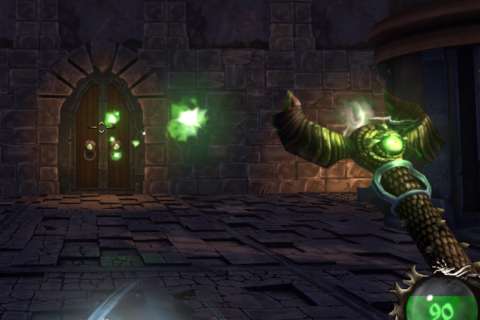
WANDS:
Just so the player knows that the player character is a magician first and foremost, his/her default weapon is always the wand.
Wands have limitless magic to draw from (where, it is not entirely clear). Unlike typical fall-back weapons, most wands do considerable damage. They also have nasty secondary fire profiles that also happen to be quite accurate. However, they can only hold so much magic and do not replenish all of their capacity immediately. Indeed, if it is not for their generally poor capacity, the wands would have been the mainstay of any player.
The two initially available player characters start out with the Soul Wand, which is the template for the other wands. The other player characters have more personalized wands. To cite some examples, one character’s wand may trade projectile speed for more damage, whereas that of another fires patterns with more shots for the same consumption rate of wand mana, but the patterns’ accuracy falters at long range.
SPELLS:
Spells are typically represented as spell-books.
The first few Spells are functionally the analog of video game shotguns, i.e. scattershot/spread-shot guns. They do more damage if the target is closer, but of course, this comes at the risk of being too close to the target in the first place. These shotgun spells mainly differ in shot patterns.
The other spells that are unlocked later make themselves different from each other through secondary effects or completely different shot patterns. For example, the Arcane Storm spell conjures lightning bolts over the heads (or equivalents) of enemies that happen to be close to the targeting cursor. This means that the player does not need to aim as much as he/she has to when using other spells, but this comes at the cost of rather inefficient mana usage. For another example, the Dragon Bile spell is practically a flamethrower.
STAVES:
The first few staves are meant to be complements to the first few spells. Since the latter behave like shotguns, the former behave like assault rifle, i.e. they have a high rate of fire and their shots are small and fast, but they have accuracy-affecting setbacks not unlike recoil. These are useful in nasty situations, such as firing wildly at a throng of enemies whom the player just has no chance of missing.
The later staves are zanier and have even more situational uses. For example, the Serpent staff – which is definitely a tribute to a certain weapon in Hexen - is not intended for straight assault; rather, it poisons enemies so that the player can shift focus to other enemies while the poison does its work. In another example, the Scarab Beetle staff is meant for use in small rooms, as their bouncing projectiles would eventually land on something despite the staff’s less-than-stellar accuracy.
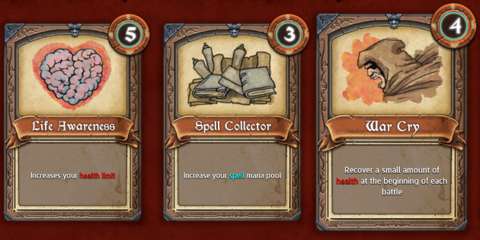
ALCHEMICAL WEAPONS:
Alchemical weapons are meant to be used against multiple targets. The first few ones are explosive, meaning that the player has to make them land in the right spot for maximum effect – that is not easy, until the player is familiar with their splash range, hitbox sizes and projectile speed.
The later ones, like the later staves and spells, have wilder modes of operation. For example, the Flame Mortar creates walls of flames, which can be handy against a horde of enemies coming down a narrow corridor. Another example is the Dark Cannon, which is likely the game’s take on Doom’s BFG.
GETTING A WEAPON EVERY LEVEL:
Every level, the player character starts in a room with a node that has a weapon floating above it. The player collects the weapon by simply running into it.
Preferably, the weapon should be of a category that the player character does not already have, or it is something that the player prefers over his/her current load-out. Otherwise, it is a waste.
Alternatively, if the player is not above save-scumming, he/she could just make a backup of the save that can be made upon completion of a level, and use this to repeatedly regenerate the next level until he/she gets something that is satisfactory. This cheat is also useful for filling up the weapon slots, if they are not filled already.
UNLOCKING MORE WEAPONS:
One of the sources of longevity in the game is finding more weapons and figuring out how to use them for run-winning strategies. As the player completes or fails runs, the game unlocks more weapons, among other things, for the player to do this.
In actual practice though, the first few weapons are actually already good enough for this purpose: they are well balanced against each other, and have decent mana efficiency. They may not have the firepower that the player might need for greater levels of difficulty, but skill at knowing when to move and when to shoot counts for more than magical firepower. Besides, the more powerful weapons tend to gobble up more mana, thus requiring the player to use strategies that are mana-centric; these strategies may not always be reliable.
NO MELEE:
Considering that the player character is armed with staves and that those spellbooks look rather hefty, there is no opportunity to use these as bludgeons. There are some short-ranged weapons that satisfy players with up-close-and-personal preferences, but these consume mana anyway.
SOME MISLEADING DESCRIPTIONS:
The overall properties of a weapon are mentioned in its description, but for some weapons, they are incomplete, ambiguous or just not true in some scenarios. For example, the Skull of Xanatos spell fires a magic skull that seeks out enemies. Most of the time, it finds its target, but it can overshoot a target, after which it just continues flying and hit something else, effectively missing – something that contradicts its in-game description.

NO DAMAGE TYPES:
Despite the names of some weapons, such as “Fire”-this or “Ice”-that, there does not seem to be any system of magic elements or damage types. This could have made the game a bit more complex. However, with just four weapon slots and no means of modifying gear loadout on the fly, this gameplay element might not have been feasible.
RUNNING ABOUT:
Ultimately, the player’s familiarity with the weapons is less important than knowing when and where to move. In addition to helping the player evade or dodge enemies, this knowledge helps the player know where to be in order to make use of said weapons. Of course, this knowledge is earned through experience. Players who remember the days of Quake and Unreal Tournament would already have an inherent advantage in this matter, but any player could eventually learn, either through tips on the Internet or learning them the hard way.
That all said, most player characters move at a considerable clip. Generally, faster is better, assuming that the player could get used to astonishingly fast speeds (and is wise enough to disable motion blur).
LEVEL MAP:
The Ziggurat has several floors, each of which is a “level”. A level is composed of rooms and the antechambers between them.
The player can bring up the level map, which shows the rooms and the connections between them on the current floor. The level map has a legend, as well as an icon for the player character that also shows his/her facing. This is handy for helping the player figure out where to go next.
HAZARD ROOMS:
There are some rooms that lack any enemies. Instead, these rooms have traps that cannot be disabled in any way. Appropriately, the game calls these “hazard rooms”.
There are two grades of hazard rooms; they are colour-coded. The yellow ones have lower densities and can be circumvented with some easy timing. In the game, they are there as nuisances that would punish players that are careless.
The red ones are dense with traps. Players who have played games with rooms that have absurd densities of traps would be quite familiar with these rooms. Careful observation can help the player figure out the timing for the player character’s jumps and sprints.
This observation is not limited to just sight; there are hazard rooms that block the player’s view with opaque obstacles, so the player will need to rely on sounds. Indeed, some traps emit audio cues before they trigger, such as lightning burst traps and spike traps.
The red hazard rooms have sarcophagi that contain the reward for getting past the traps. Usually, these contain amulets, which will be described later, and at least one perk each. They may also contain weapons.
In hindsight, it is fortunate that the developers have not thought about putting environmental traps in rooms with enemies. That would have been unpleasant for players who rather not have so many things to deal with. Conversely, it would have been too much in the favour of players who are skilled at making traps do the work of killing enemies for them – assuming that the traps could have injured enemies, of course.
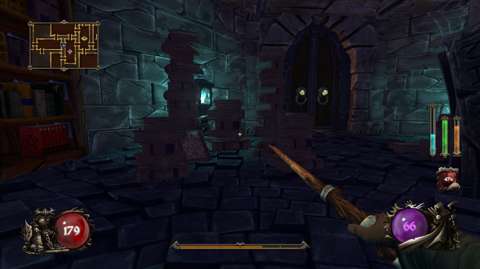
TREASURE ROOMS:
Some rooms have treasure boxes, just waiting for the player character to come close to them. All of them release goodies – mana crystals being the most common – but some of them also trigger ambushes; a disembodied laugh indicates that this is imminent.
AMULETS:
Like any competently designed rogue-lite that is about clearing an area and moving on to the next, Ziggurat has a category of items that charge up as the player makes progress at doing so. These are called “Amulets”.
Amulets are rare things. They are often found in red hazard rooms, but they might also be in treasure boxes. Even if the player has found another amulet after having already had one, the player character can only have one of these at a time.
The first few amulets are utilitarian things. One of these increases the player character’s speed, thus allowing him/her to get to somewhere else before he/she is penned in. Another is simply a healing device, which restores a percentage of health. The later ones have more exotic properties, but are more situational.
ANTECHAMBERS:
Every room in a level is connected to another one through antechambers. These may be innocuous and mundane things like corridors, tunnels and gangways. However, they may also be corridors rigged with spike traps or have lava channels flowing across them. Alternatively, they may also be small studies, with stacks of books that the player can destroy for gratuitous glee. Like other destructible objects, they may also yield loot drops.
Interestingly, every time the player saves and quits a run, and then reload it again, the antechambers are re-seeded again. Cheesing these is not so worthwhile though, due to their randomness.
HIDDEN ROOMS:
Players who have fond memories of Legend of Zelda: Link to the Past and the indie games that it inspired might think that there are such things as secret rooms, when they see the level map for the first time. There are indeed such rooms.
Just like in Link to the Past, the player will want to look out for walls that are badly cracked. Additionally, these walls always appear where doors would usually be, so finding them is even easier after the player has been made aware of their existence. They do take considerable damage before they are destroyed however, so the player should not expect the rigours of battle to somehow reveal their presence.
Their rewards are usually a beneficial perk, or a give-or-take one (more on perks later). These rooms also have murals or paintings. These may be concept artwork for the game, but some are references to the game-maker’s previous games; approaching them gives the player some hindsight-laden remarks that the game-maker has about them.
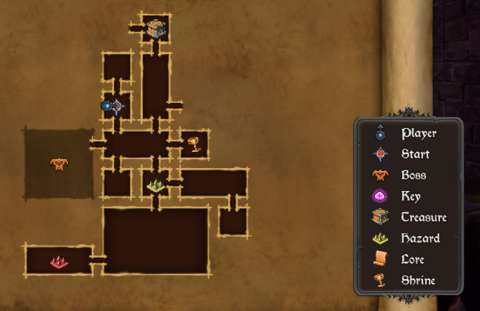
COVER:
Some rooms are wide-open spaces, thus allowing the player to shoot at monsters easily and vice versa. Some others have obstacles that impede both the player character and the enemies. These obstacles include barrels, which the player and enemies can destroy with a single hit.
The other obstacles are pillars and remains of brick walls. However, enemies can destroy them with their own ranged attacks. This means that no piece of cover could ever last the player for long.
DAISES, STAIRCASES AND RAMPARTS:
Daises, staircases and ramparts allow the player character to gain some verticality over enemies. This makes their aim awkward, making it easier to dodge their ranged attacks. The vertical surfaces of these objects are also indestructible, which make them far more reliable at being cover.
That said, the player should not expect the presence of suspended platforms under which enemies or the player character could go under, while somebody else is on the platforms. The game’s level designs are not that sophisticated.
FENCES:
Fences block movement, but do not prevent projectiles from passing through. There are some rooms that have these, likely for the purpose of preventing deaths from falling into pits.
EXPERIENCE:
Any rogue-lite these days are rarely without a progression system of some kind. Ziggurat has this too.
The player character does not gain experience automatically after defeating enemies. Instead, they drop “knowledge gems”, to use the game’s own words. The player must pick these up in order to gain any experience points. There are also gemmed chalices, which can be dropped by defeated enemies instead of knowledge gems. Barrels and bookstacks also rarely drop gemmed chalices, which can yield experience points if the player took a perk that enables this.
A meter at the bottom of the screen fills up as the player gathers more experience. Having more level-ups make the next subsequent ones require more experience. Filling the meter leads to a level-up; the meter automatically resets, so the player character can continue to accumulate any experience.
A level-up guarantees increments to the health and mana capacities of the player character. These are needed to maintain the player character’s level of power relative to the increasing challenge of the Ziggurat. A level-up also restores some of the player character’s health, typically by the amount at which his/her health capacity increased.
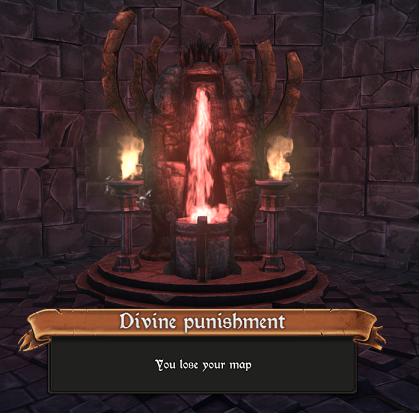
PERKS:
In addition to the stat improvements, the player gains the opportunity to choose a perk for the player character when he/she gains a level-up. Instead of picking a perk immediately, the player can choose to hoard the perk gains for later, perhaps after the player has somehow gained a perk to make subsequent perk choices more valuable. Thanks to the stat improvements, this strategy is not too risky.
When the player deigns to select a perk, he/she is given one of two choices, by default: the player must choose one before being able to progress. This process repeats until the player has expended all hoarded perk gains. A certain perk increases the number of choices, though this is best taken early.
Some of the first few perks grant the player character long-term benefits with no short-term ones. These include increments to health and mana capacities, but no complementary health or mana (meaning that the meters for these seem emptier after the player takes these perks). The others of the first few perks provide short-term benefits instead, such as complete refills of mana or health; these are best taken if the player is at risk of losing a run.
Most wise players would pick perks with long-term benefits; wily and dastardly ones pick these too, and use exploits to refill health and mana.
The later perks have zany properties. An example is Amnesia, which swaps mana capacities around and also increases their maxima. Some others have situational uses, like a perk that reduces the mana usage of secondary fires, which are usually mana-intensive.
Unfortunately, since the player is forced to pick a perk out of whatever is given to the player, the player might get into a scenario where none of the perks are desired. There does not seem to be any way to re-roll the offerings.
PERK LEVELS:
Some perks can be taken more than once. This is especially so for the capacity-increasing ones. Doing so stacks the application of benefits from the perks. Indeed, a player character could have hundreds of hitpoints from perks that increase their health capacity.
There do not appear to be any ways to remove or swap perks for others.
SHRINES:
Shrines are rooms where the player can find statues that are dedicated to the “Elder Gods”. (Lovecraftian fans might be disappointed by their appearance though; instead of Elder Gods that look like Cthulu or its ilk, the Elder Gods look more like bearded horned warriors.)
Anyway, there are three of the statues; each can only be used once. One demands nothing in return, one demands a portion of the player character’s health and one demands a considerable amount of any of the player’s mana.
Afterwards, there is one of three outcomes. One of them is positive, granting benefits not unlike capacity-increasing perks. One of them is zero-sum; the player character gains a benefit and a detriment. The third outcome is completely negative; the gods have deemed it fit to punish the player.
The fickleness is perhaps not an issue for the statue that demands nothing. However, having to suffer penalties for having paid mana or health is a very unpleasant experience. Fortunately, players who have no issue about cheating to compensate for bad luck can just save-scum until the statues give benefits.
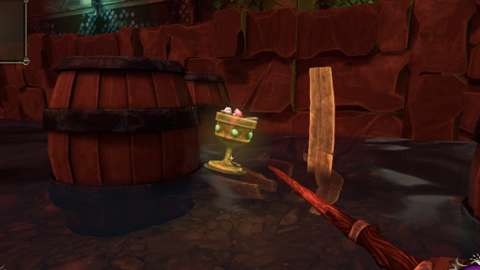
PORTAL KEY & SCROLL ROOMS:
Some rooms are devoid of enemies, but have portal keys and scrolls instead. These might just be sitting around waiting to be picked up, but some of these rooms have minor 3D platforming challenges in them.
Portal keys are needed in order to advance in the playthrough, because without these, the player cannot summon the “guardian” of the floor (more on this later). They otherwise do little else.
Scrolls are journal pages that had been left behind by previous aspirants; why they are placed on podiums and altars is anyone’s guess. Anyway, the pages describe some of the denizens of the ziggurat or make some remarks about its nature, but the player should not expect any more than attempts by the story-writers to emphasize the mysterious and dangerous nature of the Ziggurat. For the player’s trouble, the player character is given some experience points.
FIGHT ROOMS:
Most rooms in any level force the player character into a fight when he/she enters the room. The player is prevented from saving and quitting, and all doors are locked to hem the player character into the rooms. Then, enemies spawn into the rooms. If the rooms do not have any other complications to throw at the player, the player is shown a red-filled meter that indicates the proportion of enemies that still have to be killed in order to escape and progress.
ENEMY SPAWNING:
Not all enemies that will spawn into a room will spawn immediately. Some will spawn on the far side of the room, so the player has some time and distance to think about what do so. Indeed, enemies will always spawn at a certain distance away from the player character.
However, if the player character moves, additional enemies will spawn where the player character was. This can be unpleasant to learn the hard way, especially if the player character is backpedalling away from enemies towards where he/she was.

OBELISKS:
Some rooms spawn Obelisks, which are edifices with large pearls (or at least they look like pearls). These cause monsters to continuously spawn as long as they are still operating.
Interestingly, there are a couple of ways to destroy them. The first is to of course shoot the hell out of them. The second is to shoot at the pearls. This causes the pearls to dislodge, causing considerable damage. However, the obelisks spin, so the player character has to be repositioned to shoot at the remaining pearls.
The monsters that the obelisks spawn have very low chances of dropping any loot, which means that farming them is generally a bad idea. This also means that the player would be rushing from one side of the room to another to blow them up, avoiding any monsters along the way so as to conserve mana. This is a risky strategy. Afterwards, the monsters that have been spawned still have to be killed, and they still have lousy drop rates.
Obelisks obviously make things more difficult. However, the player is rewarded for this greater challenge with a considerable amount of loot from destroyed Obelisks.
SCAVENGE HUNTS:
There is another kind of room that causes monsters to spawn continuously. This is the “Scavenge Hunt”. Purple gems spawn into the room, and the player character has to collect them all in order to stop the spawning.
This can be difficult, because the gems do not all spawn into the room at once, so the player cannot plan a route. A cluster of them appears first, often on the other side of the room. After the player has collected them, another cluster appears in the other side of the room. This requires the player to turn around and somehow evade the gaggle of monsters that had been spawned. This can be a problem.
Unfortunately, the reward is not commensurate with the challenge. The purple gems do give something when they are collected, but they are often not worth the trouble of dealing with the spawning enemies and having to run after the gems.
ROOM MODIFIERS:
In addition to Obelisks and Scavenge Hunts, rooms may have modifiers that affect the statistics of monsters and the player character, among other things such as the types of monsters that are spawned.
Most of them are understandable from the get-go, but some others are only understandable in hindsight. For example, there is a modifier that makes only large monsters spawn; some players might think that larger versions of pre-existing monsters would spawn, but the modifier only means that pre-existing monsters that happen to be larger than the others will spawn.
Usually, a modifier that is detrimental to the player comes with an advantage that evens the odds. However, there are moments where only one kind of modifier is active, which may be in the player’s favour or to his/her disadvantage.
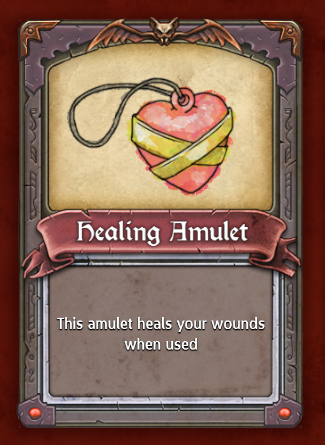
ENEMIES – OVERVIEW:
Most of the enemies in the game are inhuman things, though not all of them look hideous. Some do look goofy, such as the slimes that sway from side to side in their idle animatons.
All of them behave almost similarly. They always know where the player character is, and will always try to go after him/her. In the case of enemies with ranged attacks, they will always try to have clear lines of fire to the player character, and when they do, they completely stop before going into their attack animations.
As for their ranged attacks, observant players might notice that each type of ranged attack has peculiar patterns that can be evaded if the player character makes a jump or strafes at the right time. The tricky part is dealing with multiple patterns. Some experience with shoot-‘em-ups might be valuable for this purpose.
In the case of enemies with only melee attacks, they will always try to close the distance. This can be a problem, especially if the player has found a convenient area within a room that happens to have convenient cover.
Some enemies have different behaviours when the player character is close. Some pound the ground to create shockwaves. Some others resort to melee attacks. This behaviour can be exploited to land cheap hits on them, or goad them into wasting their time on melee attacks while the player character puts distance between them.
FLYING ENEMIES:
Flying enemies are perhaps more dangerous than non-flying ones, mainly because they can fly over cover and they are hard to hit with weapons that have parabolic trajectories. Fortunately, flying enemies are less common than non-flying ones.
Perhaps the most irksome problem about flying enemies is that the player would have to kill them over solid ground that the player character can reach if the player wants their loot drops. Otherwise, they might fall into places that the player character cannot reach, like deep pits, and where even the player character’s ability to attract loot drops would not work.
STRONGER ENEMIES AND PALETTE SWAPS:
Some monsters happen to be more powerful than the rest. Their model sizes are slightly bigger, and they have colour tints that make them stand out more. The colour tints indicate the strengths that they have, though the player has to learn this from experience because there is no readily available documentation on this in-game.
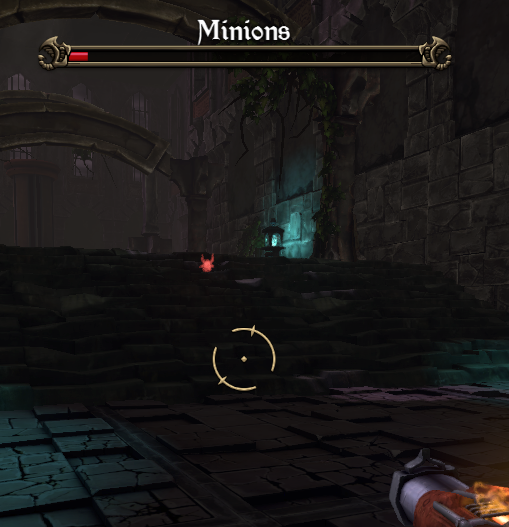
CARROTS:
Perhaps the most dangerous monsters are the Carrots. These are actually mandrakes, according a lore scroll. However, for humorous purposes, they are just called Carrots because they do look like the vegetables.
Anyway, these are the fastest ground-based monsters in the game. Indeed, they can outrun the player character if he/she is not sprinting. This means that pursuing Carrots can eventually attack the player character if the player does not do something about them.
They can hem the player character in if a bunch of them manages to corner him/her. Interestingly, they are short enough for the player character to simply jump over them. However, the hitboxes of their bites are big enough to extend well over their models, so they can bite the player character if he/she jumps over their heads anyway.
BOSSES:
There are monsters that are more powerful than the rest; these are the “guardians” of the floors, and they are greatly implied to be evil beings that have been deliberately trapped in the ziggurat for use as challenges.
The bosses can summon lesser monsters (typically those that resemble them), and have attack patterns that are different from those of the lesser monsters. They also have different behaviours too. For example, the ones that resemble melee-only monsters do not mindlessly chasse after the player; rather, they have ranged attacks that they will use.
Boss fights are ultimately battles of attrition, because there are next to no means of gaining health or mana replenishment when fighting them. The lesser monsters that they summon can be killed, but unless the player character has perks that increase loot drops from them, they are not worth focusing on until their bosses are dead.
LOOT FROM BOSSES:
As to be expected of particularly powerful monsters, the rewards to be had from challenging them are considerable. They are likely to spill enough healing potions to restore most of the player character’s health, as well as a lot of mana and experience-yielding loot. Their demise also causes the portal to the next floor of the ziggurat to appear.
However, the player might want to inflict the killing blow when they are well away from the portal. The presence of the portal causes any loot that dropped on or near it to have their retrieval scripts bugged, i.e. the player character cannot draw them in and absorb them, even in close proximity.
Of course, if the player character is already at where the portal is, the player immediately ends the level, whether he/she wants to or not.
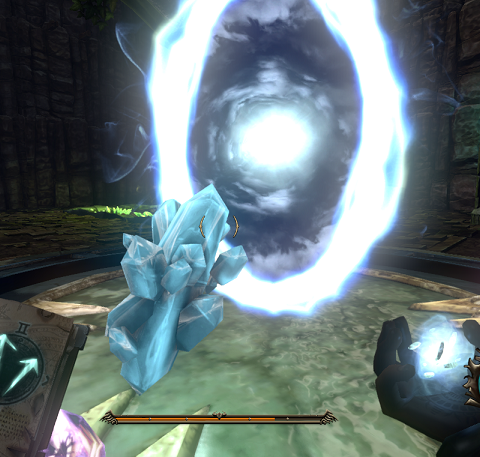
ENEMIES GETTING STUCK IN THINGS:
The pathfinding scripts of the monsters are simply terrible. They may know where the player character is all the time, but they are quite oblivious about obstacles in their way. This is especially so for fences and monsters that rely on melee attacks; it would appear that their pathfinding scripts are based on their lines of sight. Since fences do not block line of sight, these melee-oriented monsters would run into fences and continue doing so.
DIFFICULTY SETTINGS:
If the player is looking for a greater challenge, the player could play at higher difficulty settings. This makes monsters more powerful, among other statistical changes.
Ultimately though, what the player would likely do differently the next time around at higher difficulties is prioritize certain load-outs; the player will still be using strategies that exploit the limited intelligence of the monsters. Indeed, at higher difficulties, the player will still be doing the same thing: minimizing damage from enemies and maximizing damage done to them. There is not much in the way of emergent gameplay, other than curious experimentation.
ENDLESS MODE:
In addition to the usual options to ramp up the “difficulty”, the player could play in Endless mode instead. As its name suggests, the player’s playthrough will not end; there is no “final floor”. Instead, the monsters just keep getting tougher, from floor to floor, until the math no longer works in the player’s favour, no matter how skilled he/she is.
Perhaps this mode is intended for those who want a quantifiable measurement for how good they are at this game. To anyone who is not really looking for something to prove, it can seem all too banal rather quickly.
GAUNTLET MODE:
There are players who had been arguing that the room-by-room format of the gameplay makes the gameplay easy to exploit, especially for wily players who would squeeze every advantage from any floor layout. Therefore, there is Gauntlet mode, which tosses the player character into a room and populates it with monster after monster, until attrition or a mistake takes its toll.
This mode is the best way to measure how good a player is at the Quake-like gameplay of Ziggurat. Like the Endless mode, it is there for people who have something to prove.
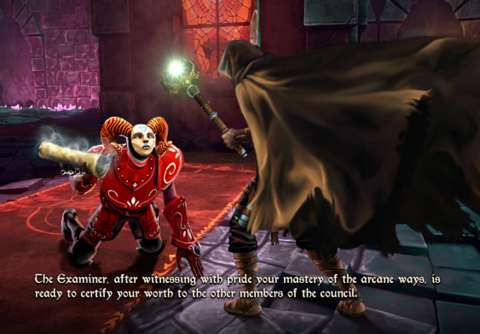
VISUAL DESIGNS - OVERVIEW:
Even during 2014, Ziggurat was not trying to push the envelope on graphics. Besides, the density of monster can get to considerable levels; pushing cutting-edge graphics is likely to turn out badly for the game. Therefore, Ziggurat uses simple-to-implement graphics whenever it could get away with it.
Models of monsters heavily use jiggle-bones physics whenever they could, such as the models for killer fungi and the slimes. For monsters that are not thematically amorphous, the monsters are heavily armored or are outright constructs so that they could be animated with appropriately awkward – and simple – animations. A lot of monsters float and hover too, and wing animations are comically repetitive.
All these clever ways to reduce complex animations greatly minimize the computing overhead that the game needs.
Since the game has no multiplayer whatsoever, the player character’s model isn’t even made further beyond his/her arms, which are conveniently garbed in ways that do not indicate their gender. Fortunately, the game does not scrimp on the models for the monsters; each type of monster has a distinctive model that makes it easy to recognize.
There is the option of having motion blur, though wise players would likely just disable this visual effect so as to have clear peripheral vision.
Loot drops eventually disappear. When they are about to disappear, they appear to throb; their models expand and contract repeatedly. They cannot be seen through opaque obstacles, however.
This being a game that has magic, Ziggurat’s developers have certainly used the setting to implement a lot of particle effects. Sparkly projectiles are particularly common, whether these are fired by enemies or the player character.
SOUND DESIGNS:
There can only be so much music for dungeons and other foreboding magical prisons that can be heard before a jaded player no longer finds any of them particularly memorable. This is the case for me. Granted, none of the tracks are terrible to listen to. Not one of them is composed in such a manner as to be grating to the nerves when it eventually loops.
I would make similar remarks about the sound effects for attacks in this game. I have heard so many magical warbles and boppity-boops, among other noises, that none of those in this game stand out to me. Nevertheless, like the music, these sounds were not dissatisfying.
Listening to the audio cues that indicate incoming enemy spawns is notably important though. The sound clip for this occurrence is a distinctly unique one, and can be heard over just about everything else. Combined with awareness of where the player character is and knowledge about the rules that control the spawning of enemies, the observant player can have a good idea of where the fresh enemies are.
Only a few characters in the game have legible voice-overs. The narrator is one of them, and so is the final boss. The narrator is notable, if only because he set up the game’s premise, which was not fully utilized and exploited.
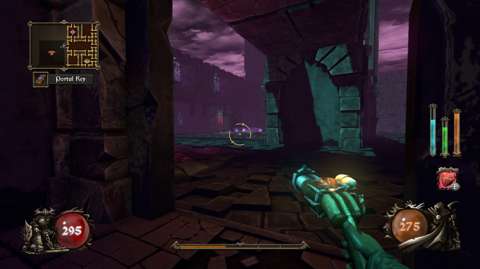
SUMMARY:
Ziggurat is a tribute to the days of Hexen and Heretic, among other things like Legend of Zelda: Link to the Past. There are also the tight controls, which might be gratifying to players who have fond memories of the days of Quake. Yet, it seems to rely on nostalgia to sell itself, because it has little of anything that is particularly innovative.
Its overarching gameplay would not be much of anything different from other run-based rogue-lites: tweak the strategy formula to come up with another, and see how it does. Furthermore, Ziggurat has the usual factors of luck that limit the player’s choices. People who have already played a lot of these would find Ziggurat all too familiar.
There may also be some problems with its longevity. There can only be so much fun to be had from the functionally similar player characters and ultimately limited enemy variety before the gameplay starts to become stale, especially for players who have already played a lot of permadeath rogue-lites.
Still, there is nothing that is terribly incompetent about Ziggurat. It is a decent game – but there are so many others that could be played instead of it.

